How to make the best homemade body butter with 2 simple, natural ingredients. This DIY whipped body butter feels luxurious and delivers maximum moisture to the skin. Let me show you how to make non-greasy body butter that works for any skin type.
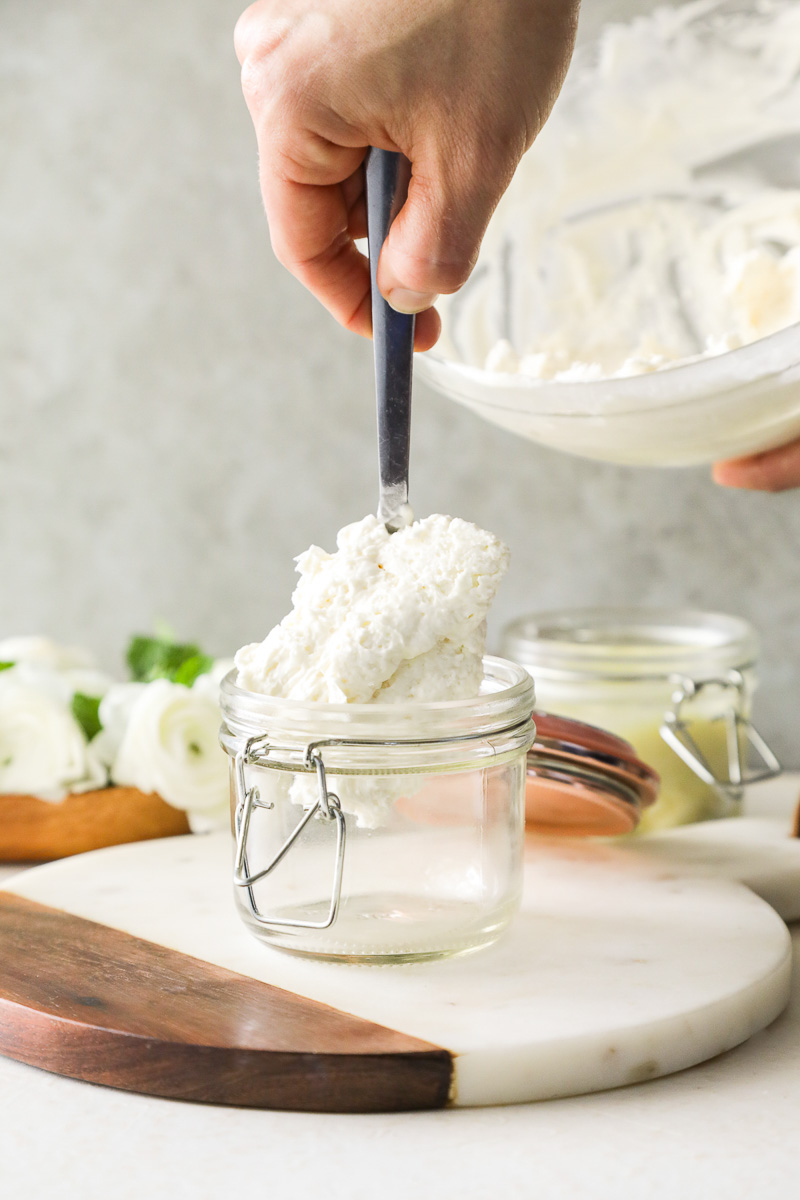
Want to Save This Article?
Enter your email & I’ll send it straight to your inbox. And you’ll get new recipes & tips each week.
Body butters are no strangers to Live Simply. First, we made this ultra-moisturizing shea butter lotion. Then we made a simple lip balm and shea butter cream facial moisturizer.
Today, we’re making silky smooth body butter for the whole body: face, arms, legs, wherever you need moisture.
In this post, I’ll guide you through making homemade body butter via photos and a video.
Key Takeaways
- Simple Ingredients – You’ll need skincare butter (shea butter, mango butter, or cocoa butter), carrier oil, and two optional ingredients- arrowroot starch/flour (to reduce the greasy feel) and essential oil.
- Easy to Make – Melt the ingredients, chill in the fridge, then use a fork or hand mixer to whip. That’s it!
- Inexpensive – Body butter can cost a fortune if you buy it at the store, particularly from a natural company. Making body products, like body butter, is usually cheaper. Buying the ingredients is an extra cost, but once you have them, you can create multiple jars of your whipped body butter (and other products).
- Non-Toxic and Natural – No synthetic fragrances, preservatives, or other unwanted ingredients. Just nourishing ingredients that are good for your skin.
- Shelf Life – 6 months
What is Body Butter?
- Moisturizing – Body butter is a rich, moisturizing skincare product made with skincare butter like shea butter and cocoa butter.
- Lotion Alternative – Body butter can be used as an alternative to lotion since its primary job is to moisturize the skin.
- Full Body Use – It may be used on the entire body, from the face to the feet.
Lotion vs. Body Butter: What’s the Difference?
- Lotion is made with water and oil (and possibly butters) so it’s light, airy, and silky smooth. Homemade lotion needs to be used within a short time or a preservative should be used (due to the water and bacterial growth). It also requires an emulsifier to properly blend the oil and water.
- Body butter is made exclusively with butter(s) and oil(s), so it’s thick and dense. Homemade body butter will last for up to 6 months without a preservative.
Both body butter and lotion are used in the same way: to moisturize the skin. Body butter does deliver more moisture since it’s not cut with water. So it’s ideal for all skin types, particularly dry skin or during the winter months.
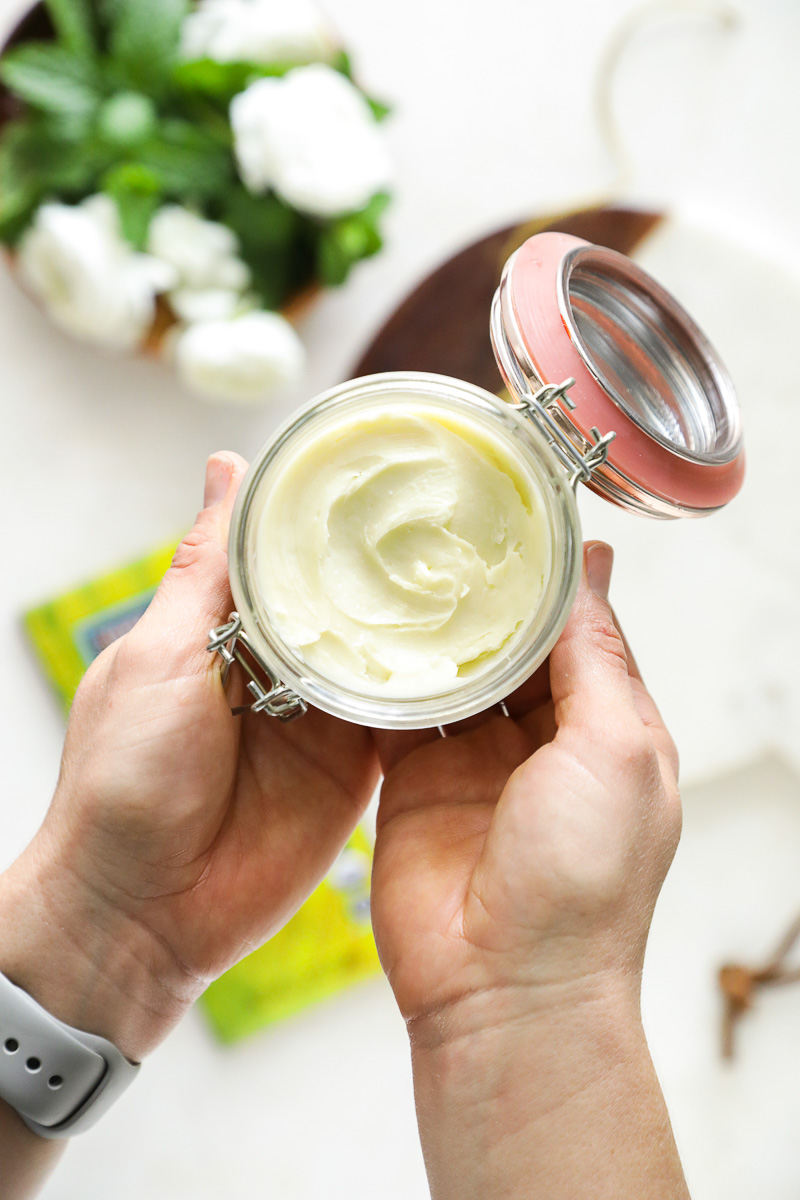
Before You Get Started: Ingredients & Equipment
DIY body butter is easy to customize to your liking. You’ll need just 2 natural ingredients.
From there, you’re welcome to add 2 additional ingredients, if desired, to make a non-greasy product or add a custom scent.
- 1/2 cup skincare butter – provides much of the moisturizing relief. Choose one of these options for the body butter: cocoa butter (hydrating and rich in vitamin E, chocolatey scent), shea butter (rich in fatty acids, vitamin E, ultra-moisturizing), or mango butter (rich in fatty acids, ultra-moisturizing).
- 1/4 cup carrier oil – nourishes and moisturizes the skin. My favorite oil options are sweet almond, olive, sunflower, avocado, jojoba, grapeseed, and coconut oil.
- 1 1/2 teaspoons arrowroot flour starch (optional) – a natural starch that helps to reduce the oily/greasy feel by absorbing.
- 36 drops favorite essential oils (optional) – add an essential oil of choice for the amazing scent.
The ingredients may be found online, some craft stores, or health food stores.
Equipment
- small saucepan – used to create a double boiler by adding water to the saucepan and placing a heat-safe bowl on top. This method protects the fragile ingredients from burning.
- glass or metal bowl (large enough to fit on top of the saucepan) – to melt the ingredients, used with the saucepan to create a double boiler.
- fork or hand-mixer – use to whip the ingredients into a spreadable butter.
- fridge – to cool the ingredients once melted.
- glass storage jar – for storing the final product.
Learn More About Each Ingredient
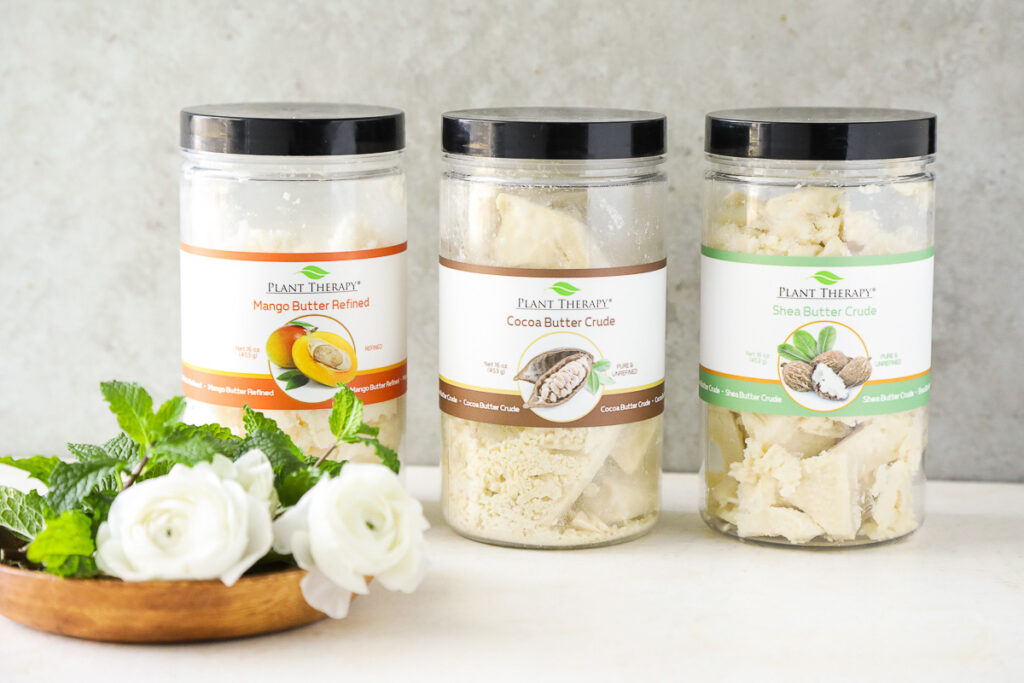
1. Butter
Homemade body butter starts with a moisturizing skincare butter. Shea butter is the perfect base butter since it’s soft, easy to work with, and melts into your skin. My recipe calls for at least a 1/4 cup of shea butter.
From there, it’s up to you, the maker, to customize the body butter. You’ll need a total of 1/2 cup of butter. So use all shea butter (for a total of 1/2 cup shea butter), or mix the shea with a different butter: 1/4 cup of cocoa butter or 1/4 cup of mango butter.
Best Butters
- Shea Butter: Shea butter comes from the “nut” (or pit) of the fruit found on the Karite Tree. It has a strong scent when it’s purchased in an unrefined state. I use unrefined shea butter in recipes (including body butter). If you don’t care for the strong scent, use refined shea butter instead. Since shea butter is naturally soft, it makes a wonderfully soft whipped body butter. It may be used on its own with a carrier oil, or combined with another butter like cocoa butter or mango butter. See all the ways you can use shea butter to make your own body products.
- Cocoa Butter: Cocoa butter comes from cocoa beans, so it has a strong scent and smells like chocolate. Cocoa butter is hard at room temperature, and it melts easily. Cocoa butter is naturally hard and dense, so if you use it, mix it with shea butter or mango butter to make a softer body butter. See other ways to use cocoa butter to make your own body products.
- Mango Butter: Mango butter comes from the seed of mango fruit. It’s naturally soft, similar to shea butter, and can have a gritty texture before melting. It yields a soft, airy body butter when mixed with shea butter. If you don’t want to use shea butter (due to allergies) in my recipe, then mango butter is the best replacement.
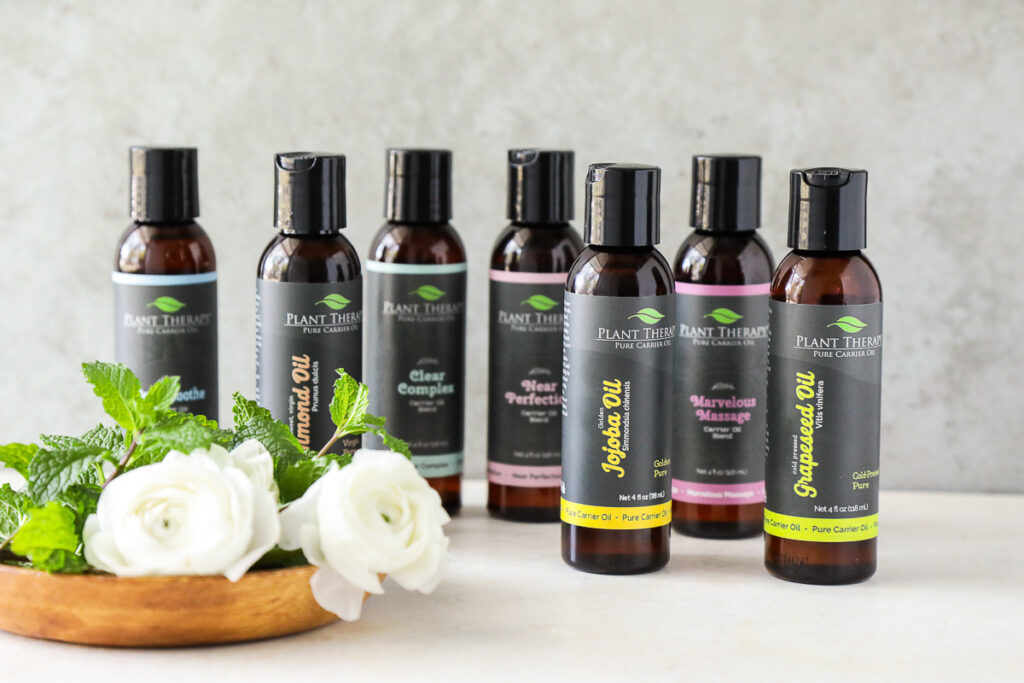
2. Carrier Oil
A liquid oil is the second main ingredient used to make body butter. The oils used in skincare recipes are known as carrier oils, although I usually call them nourishing oils. The oil used is entirely up to you.
See all the ways to use carrier oils to make your own body products.
Best Carrier Oils
- Sweet almond oil, jojoba oil, or grapeseed oil are best for making a non-greasy body butter that is easily absorbed by the skin. Great for all skin types.
- Virgin coconut oil may be used, but it can be very greasy and clog pores. Avoid if you have body acne or sensitive skin.
- Olive oil is another option; however, olive oil can be extremely heavy and feel greasy. Just like with coconut oil, this is not an option for all skin types and you may not love the results.
3. (Optional) Arrowroot Powder
Whipped body butter recipes can be very greasy!
The good news is that there’s a simple solution for this issue: add arrowroot flour/starch. Arrowroot is a natural starch (used in cooking to thicken soups, sauces, and stir-fry) that will absorb the greasy feel of the butters and oils, without drying out your skin.
Substitution: Some folks use tapioca starch and cornstarch (which are similar to arrowroot starch); however, I haven’t used these ingredients so I can’t speak to their success.
4. (Optional) Essential Oils of Your Choice
An essential oil may be added for scent and additional skincare benefits. Use just one essential oil, mix a few essential oils to create different scents, or an essential oil blend (a pre-blended bottle of essential oils). Currently, my favorite essential oils for body butter are lavender, geranium, and frankincense (carteri).
I use a 1% dilution in my body butter recipe. Before using any essential oil, read the back of the bottle for specific dilution recommendations.
Recipe Tutorial Video
How to Make Whipped Body Butter: Step By Step Guide
- Step 1: Melt the Butter in a Double Boiler. Partially fill a saucepan with water (about 1/4 of the way full). Then, place a glass (or metal) bowl on the saucepan. Place the butter(s) in the glass bowl. Turn the stovetop to medium heat, placing the double boiler on top of the heat. Allow the butter(s) to melt (about 3-5 minutes) fully.
- Step 2 Combine Oil & Carrier Oil – If you plan to use arrowroot flour, whisk the flour into the carrier oil in a small bowl. Set the mixture aside. If you’re not using arrowroot flour, skip this step.
- Step 3 Combine the Melted Butter & Oil – Carefully remove the bowl (with the melted butter inside) from the double boiler setup. Add the oil (with the arrowroot flour, if using) to the melted butter, and use a spoon to stir and combine the ingredients.
- Step 4 Chill – At this point, the oil mixture should be cooler (along with the glass bowl). If not, allow it to rest for a few minutes. Then, place the mixture in the fridge and allow it to solidify (about 30 minutes to 1 hour).
- Step 5 Add Essential Oil – Once the mixture is opaque and a bit firm (not solid as a rock), remove the bowl from the fridge. Add the essential oil of choice if desired. The essential oils must be added when the mixture is cool, as heat will cause the fragile essential oils to evaporate.
- Step 6 Whip – If you used cocoa butter, whisk the mixture with a fork until it appears “whipped.” If you used shea and/or mango butter, you can use the same technique with a fork or a hand mixer to “whip” the body butter. Just be careful not to over-whip the mixture.
- Step 7 Spoon Into a Jar – Scoop the mixture into a jar and place the lid on the jar. Now it’s ready to use!
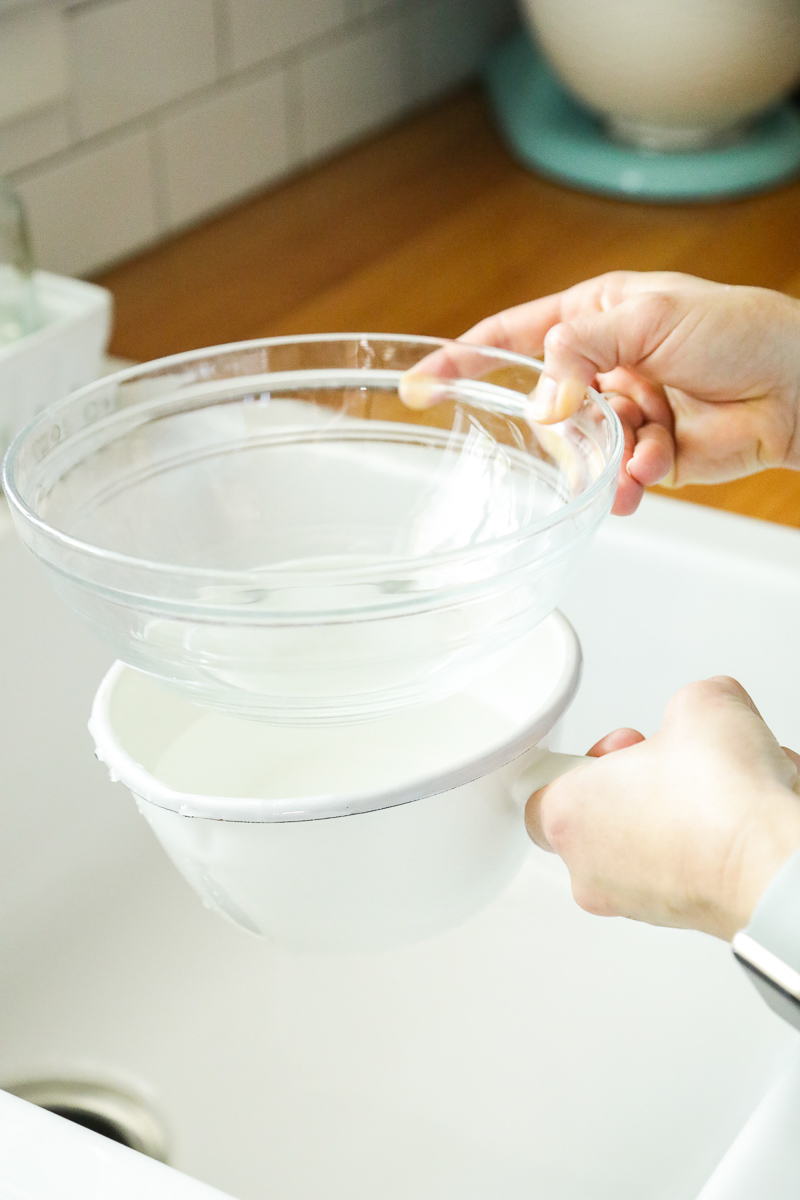

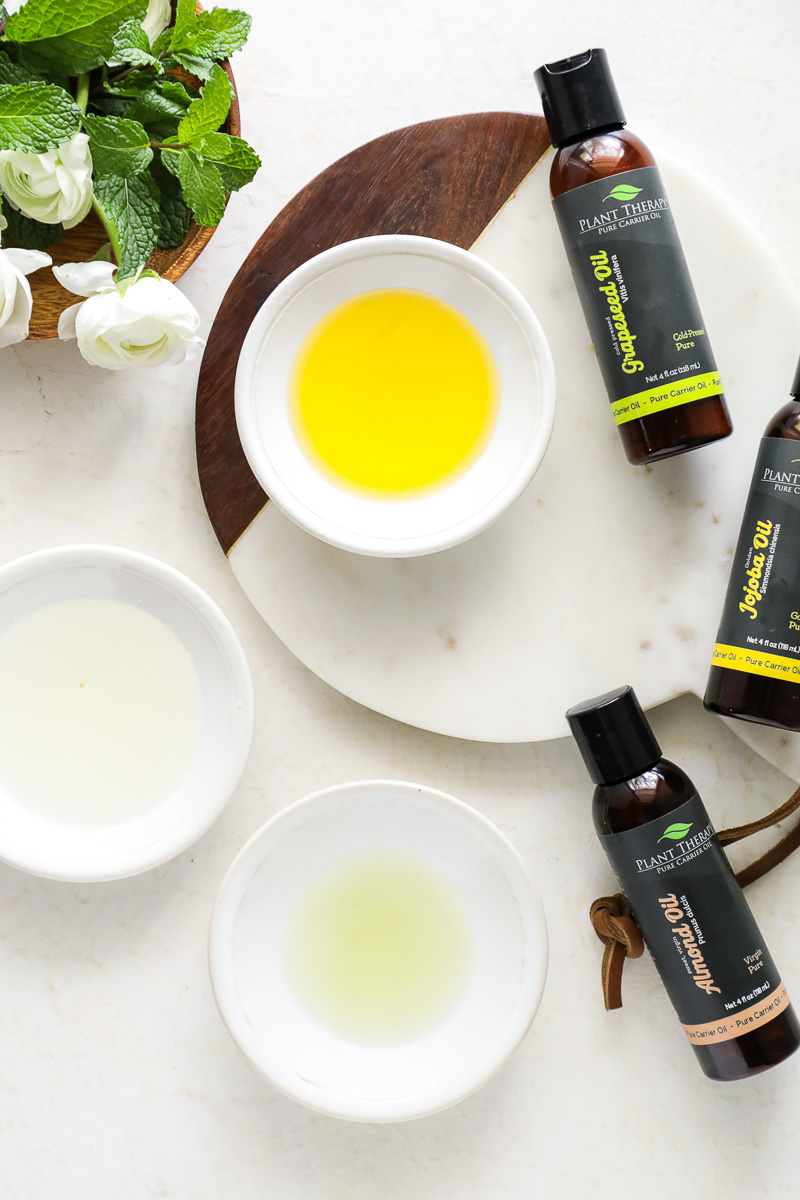
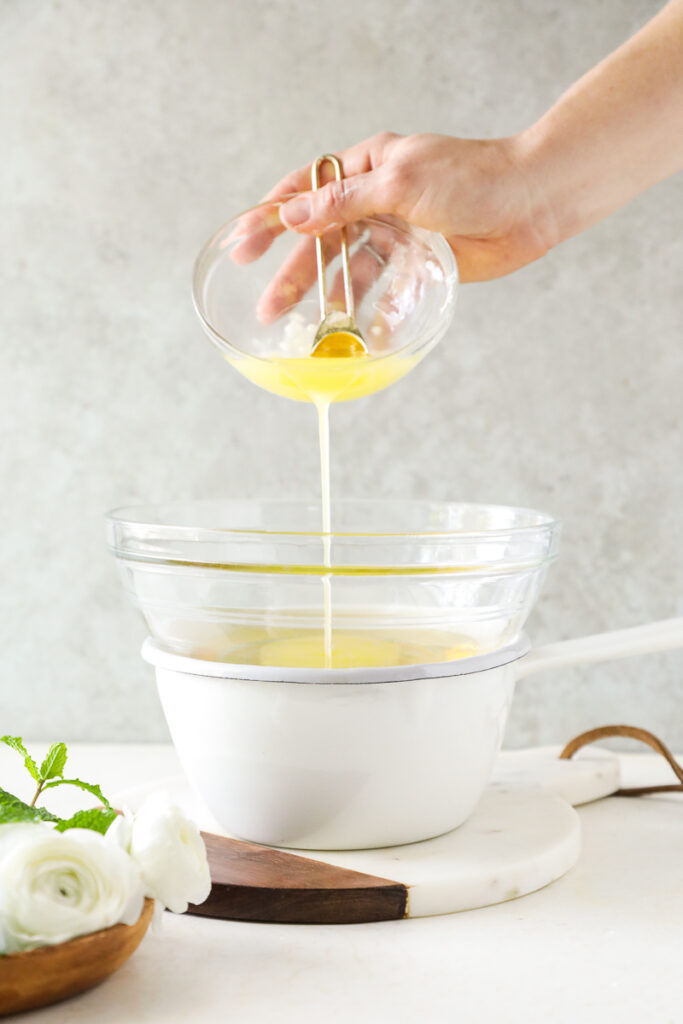

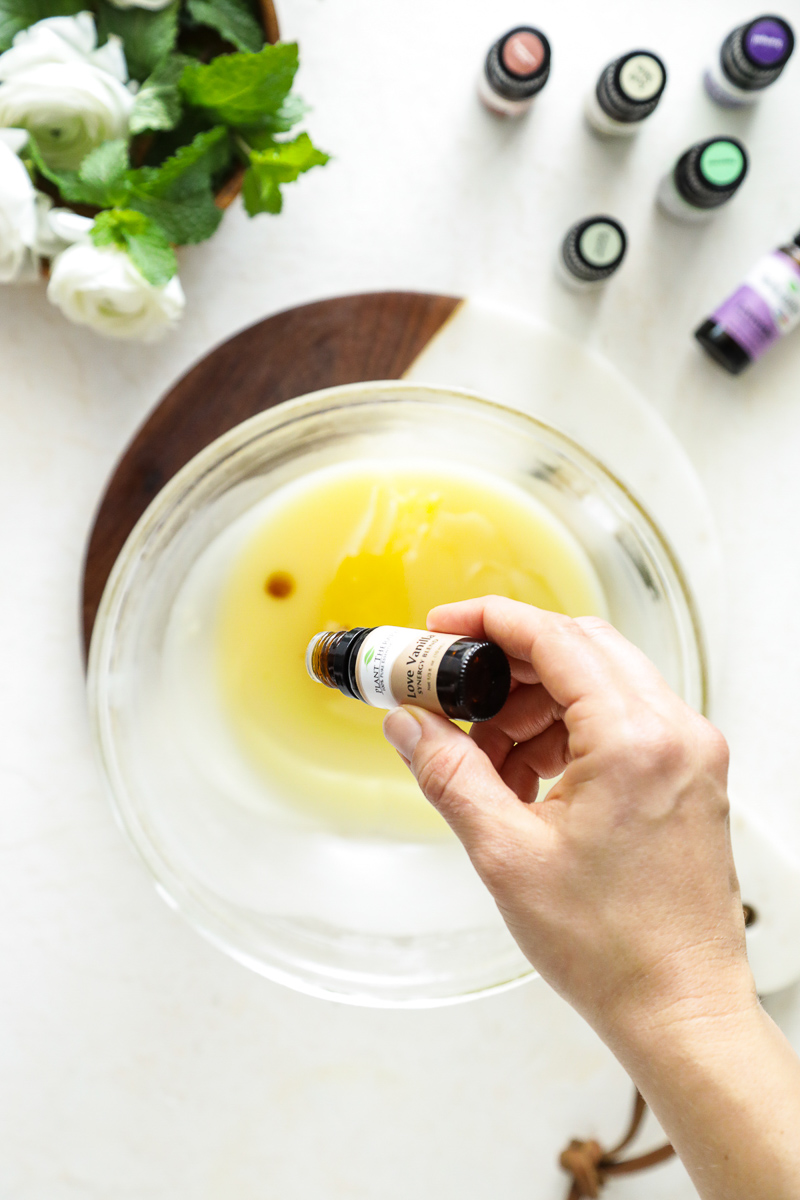
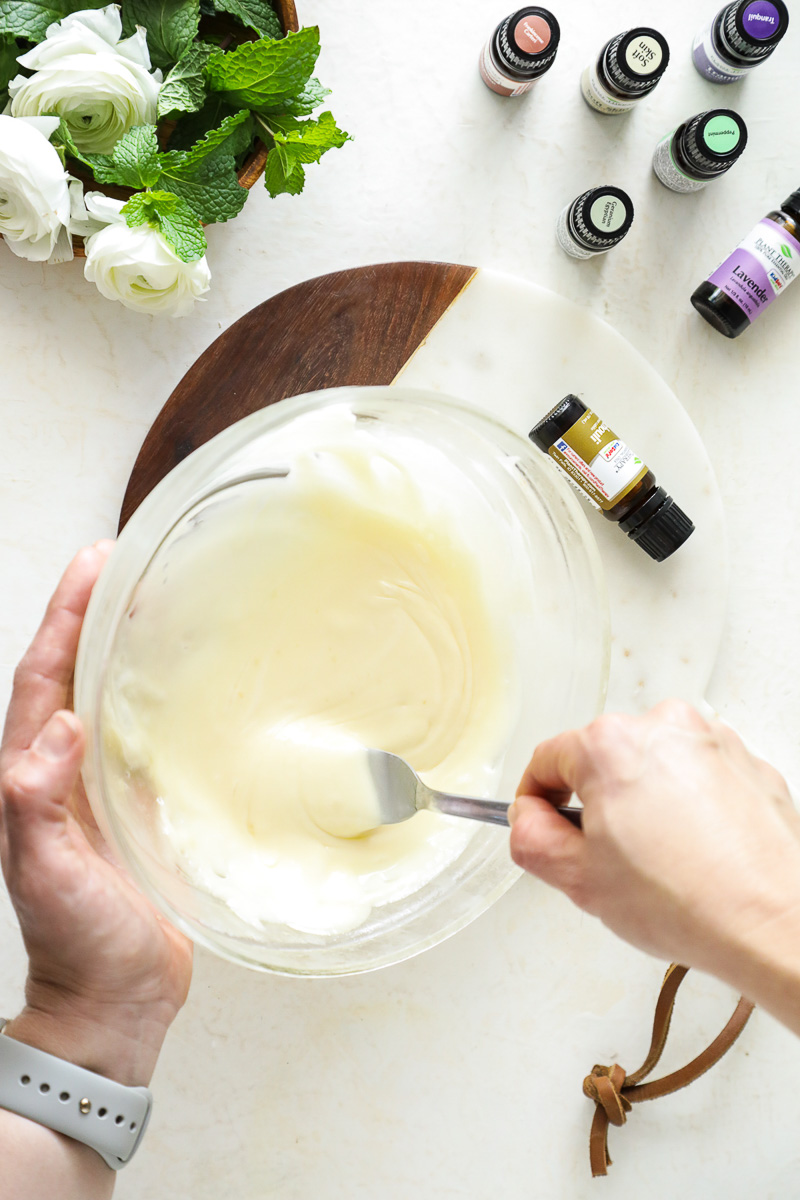
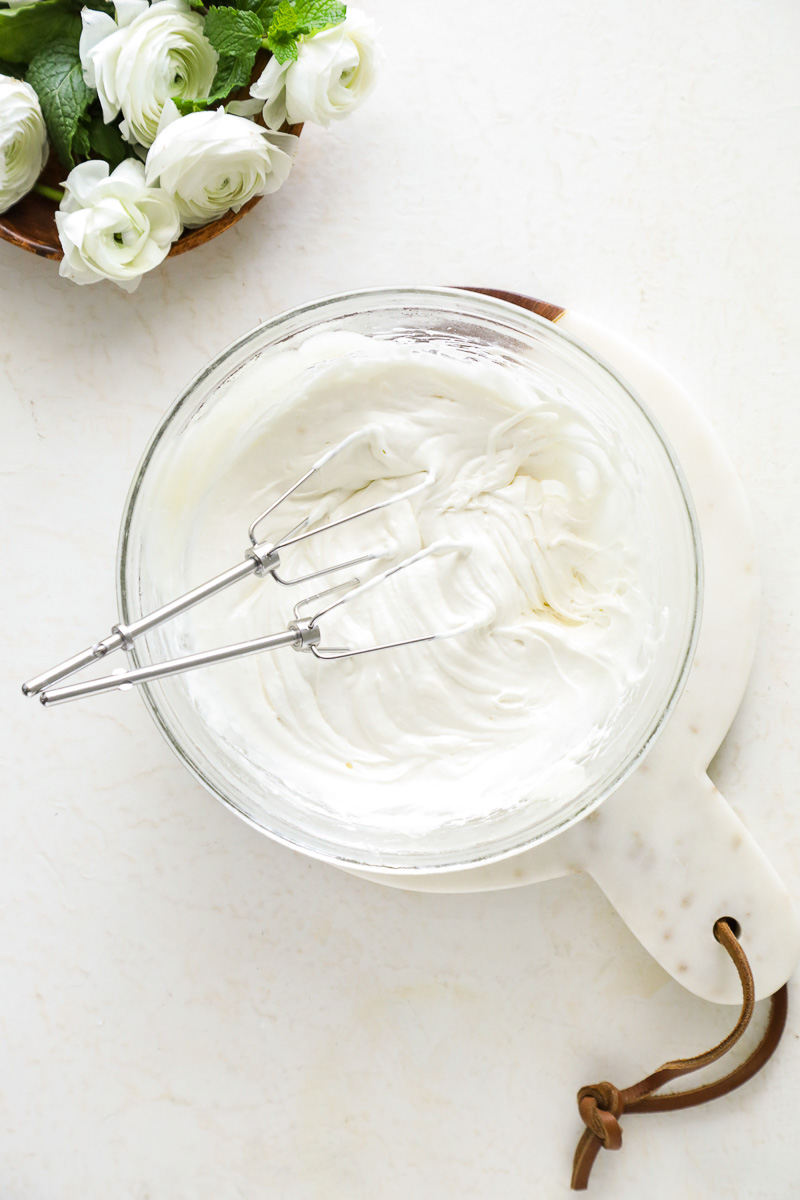

Storage: How Long Will It Last?
Store at room temperature (out of direct sunlight) in a sealed jar for up to 6 months.
What to Avoid Doing
- Don’t Use Hot Essential Oils – Some essential oils can irritate the skin and cause the skin to have a burning sensation. Avoid these “hot oils” such as cinnamon, clove, oregano, thyme, and lemongrass.
- Citrus Oils – Citrus oils, like sweet orange or lemon essential oil, are photosensitive and can make your skin more sensitive to the sun.
- Use Only a Little – If the body butter feels too oily, you’re most likely using too much. Body butter is much denser and richer than lotion (cut with water), so you don’t need much to moisturize the skin. Use a small amount, and it will absorb into the skin beautifully.
How to Prevent Hard Body Butter
If you want to create a soft, fluffier body butter, here are a few tips.
- Don’t Overwhip – When “whipping” the cooled ingredients, you only need a quick whip to create the body butter. Use a fork and whisk for 10-20 seconds for cocoa butter. For shea butter and mango butter, about 30 seconds with a hand mixer is plenty of time.
- Texture Depends on Ingredients & Temperatures – The outside temperature will affect the texture of the texture and softness of the final product. Cocoa butter will create a denser body butter. Shea butter and mango butter will create a softer final product.
- The Fluffiest Combo – Coconut oil and shea butter usually produce the fluffiest body butter.
How to Use This Product In Your Skincare Routine
Use this product anytime your skin needs moisturizing.
- Use a Small Amount – Scoop a small amount from the jar, then massage onto the skin. As you rub, the butter will melt into your skin. You only need a small amount at a time.
- Use When Skin is Damp – The best time to use this body butter is after showering when the skin is damp. Apply a small amount of product to your fingertips, then massage on the skin: arms, legs, feet, neck, and chest.
- Facial Moisturizer – This product may also be used as a moisturizer on your face. Avoid using coconut or olive oil in your formula if you plan to use it on your face. Or check out my homemade shea butter facial cream recipe.
How to Soften Body Butter Before Use: The body butter will soften or harden depending on the temperature in your home. To soften a hard body butter (which is normal and happens), place the butter in the bathroom while showering (not in direct contact with water). The hot steam of the shower will soften the body butter and make it easier to scoop out and spread on your skin.
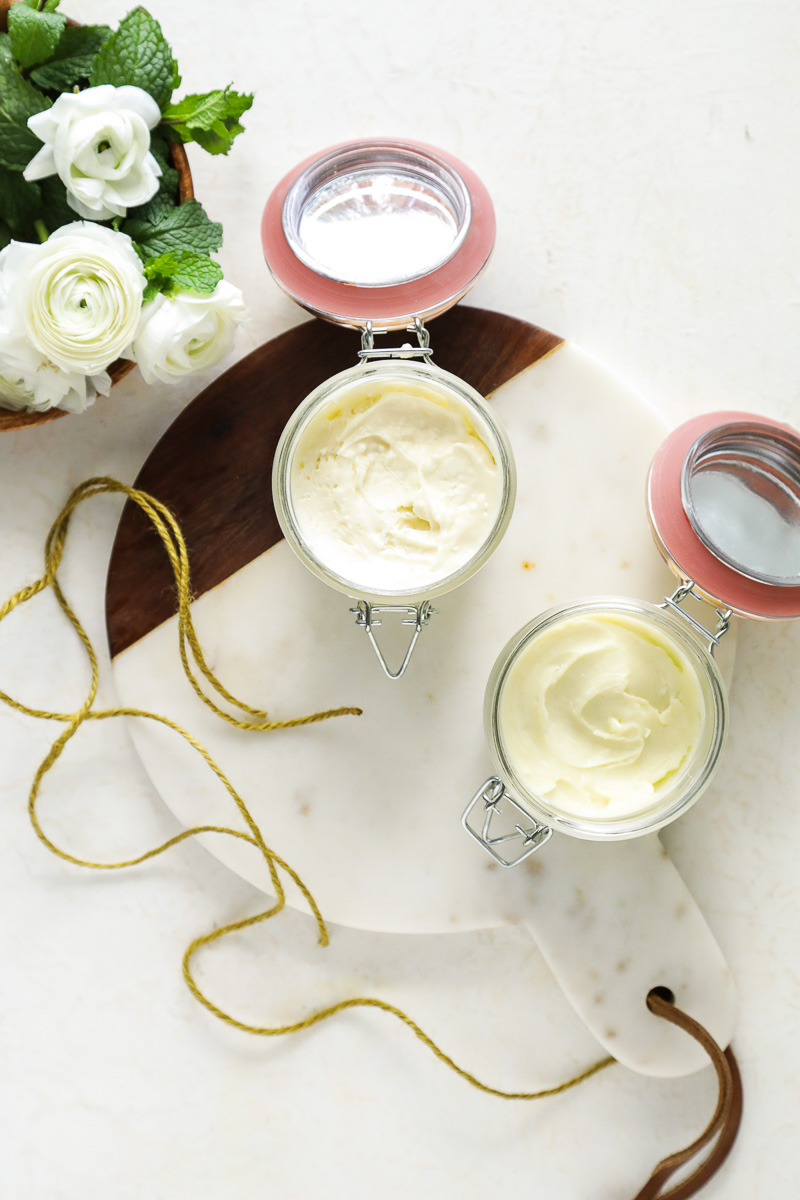
FAQs
- Do I need to use a preservative? Since water is not used to make this product, you don’t need to worry about mold or bacterial growth. Do not incorporate water into the product when scooping the butter from the jar with your hands (i.e., after a shower, washing your hands, etc.)
- You say $4-6 per jar. What size jar are you referring to? This recipe makes one 6-ounce jar. The cost will depend on the ingredients purchased.
- Can I multiply the recipe without affecting the final product? Yes, you can! You can easily double, triple, or quadruple the recipe to make multiple jars.
- Would vitamin E oil work as the carrier oil? No, vitamin E isn’t a carrier oil. You’re welcome to add a small amount of vitamin E oil if desired, but you’ll still need carrier oil.
- How long do you mix the product to avoid “over-whipping”? The answer depends on the ingredients used. For cocoa powder, just a few seconds. About 30 seconds should be enough time for shea butter and mango butter.
4 More DIY Recipes With Shea Butter
- Shea Butter Lip Balm – Use shea butter, beeswax, and oil to make a nourishing balm for chapped lips.
- Custom Lip Balm – Use any body butter of choice or oil to make this natural lip balm recipe.
- Lotion Bars – Moisturizing lotion in a solid bar, made with shea butter and beeswax.
- Face Moisturizer – Combine shea butter and oil to make an all-natural face moisturizer.
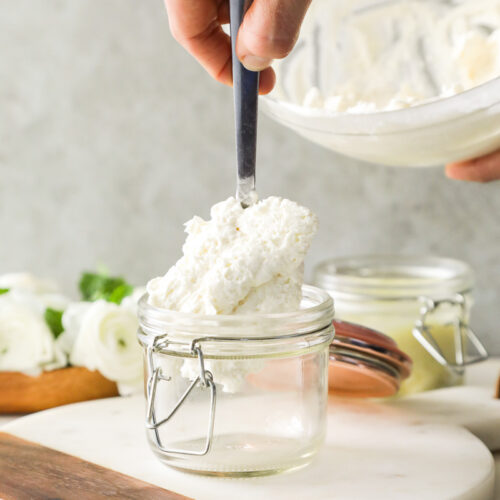
How to Make Homemade Body Butter (Non-Greasy)
Equipment
- 1 small-medium saucepan to create a double boiler and melt the butter(s)
- 1 medium glass or metal bowl big enough to rest on top of the saucepan to create a double boiler and melt the butter(s)
- 1 small bowl if using arrowroot starch to mix with the carrier oil
- 1 fork or hand-mixer to whip the body butter
- 1 glass storage jar to store the final product
Ingredients
- 1/4 cup shea butter unrefined or refined (41 grams)
- 1/4 cup mango butter or cocoa butter (41 grams mango butter or 34 grams cocoa butter or use 41 grams additional shea butter if using all shea butter)
- 1/4 cup carrier oil of choice: grapeseed oil, jojoba oil, sweet almond oil, or coconut oil (42 grams)
- 1 1/2 teaspoons arrowroot flour starch optional (5 grams)
- 36 drops essential oil of choice optional
Instructions
- First, make a double boiler: Partially fill a saucepan with water (about 1/4 the way full). Then place a glass (or metal) bowl on top of the saucepan. Place the butter(s) in the glass bowl. Turn the stove-top to medium heat, placing the double boiler on top of the heat. Allow the butter(s) to fully melt (about 3-5 minutes).
- If you're planning to use arrowroot starch/flour, in a small bowl, whisk the starch into the carrier oil of choice. Set the mixture aside. If you're not using arrowroot flour, skip this step.
- Carefully remove the glass bowl (and melted butters) from the heat source. Add the oil (with the arrowroot flour mixed in, if using), and stir to combine the ingredients.
- At this point, the mixture should be cooler (along with the bowl). If not, allow it to rest for a few minutes. Then place the bowl in the fridge and allow the mixture to solidify (about 30-60 minutes, depending on location in the fridge and fridge temperature).
- Once the mixture is opaque and a bit firm (not solid as a rock), remove the bowl from the fridge. Add the essential oil of choice, if desired.
- If you used cocoa butter, whisk the mixture with a fork until it appears "whipped." If you used shea and/or mango butters, you can use the same technique with a fork, or use a hand-mixer to "whip" the mixture. Don't over-whip!
- Spoon the whipped body butter into a glass storage jar with a lid. Place the lid on the jar. It's now ready to use. Store at room temperature (out of sunlight) for up to 6 months.
How to Use:
- Use this product anytime your skin needs moisturizing. Scoop a small amount from the jar, then massage onto the skin. As you massage, the butter will melt into your skin. You only need a small amount at a time.
- I love to use this product after bathing when my skin is still moist. I apply a small amount of product to my fingertips, then massage on my skin: arms, legs, feet, neck, chest.
Video
Notes
Natural Body-Care Simplified
Learn how to make your own body and beauty products with simple ingredients.

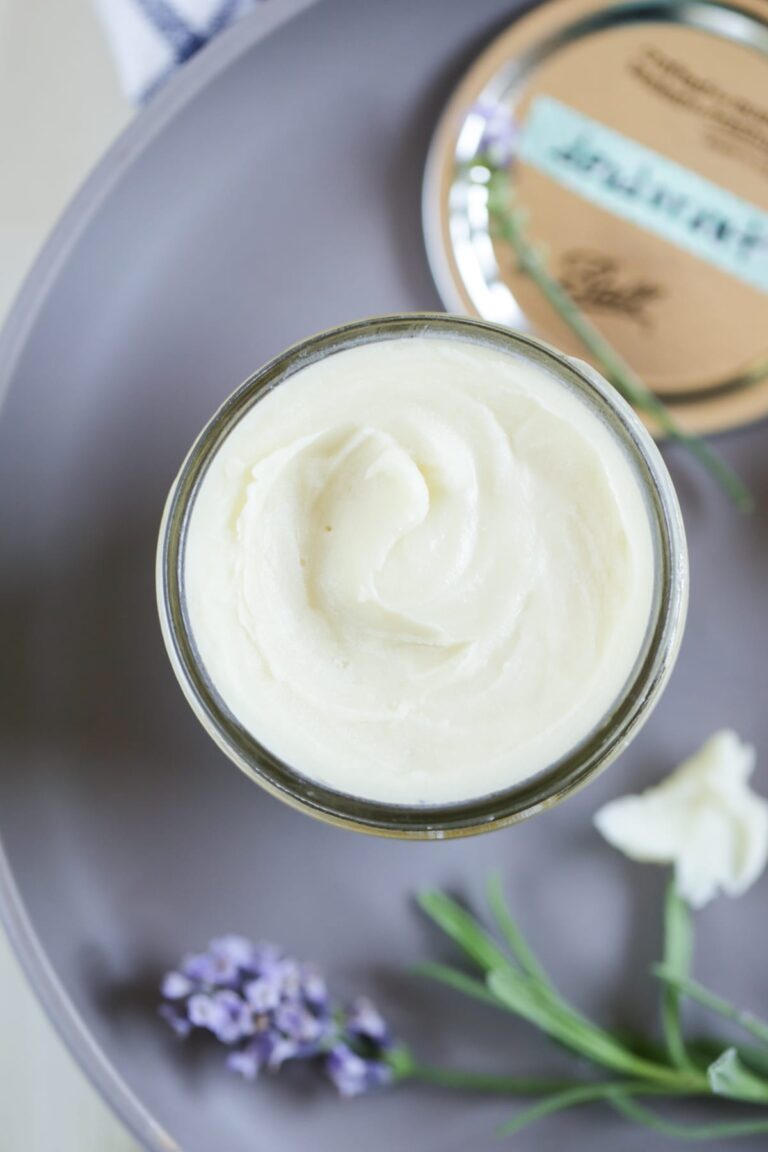
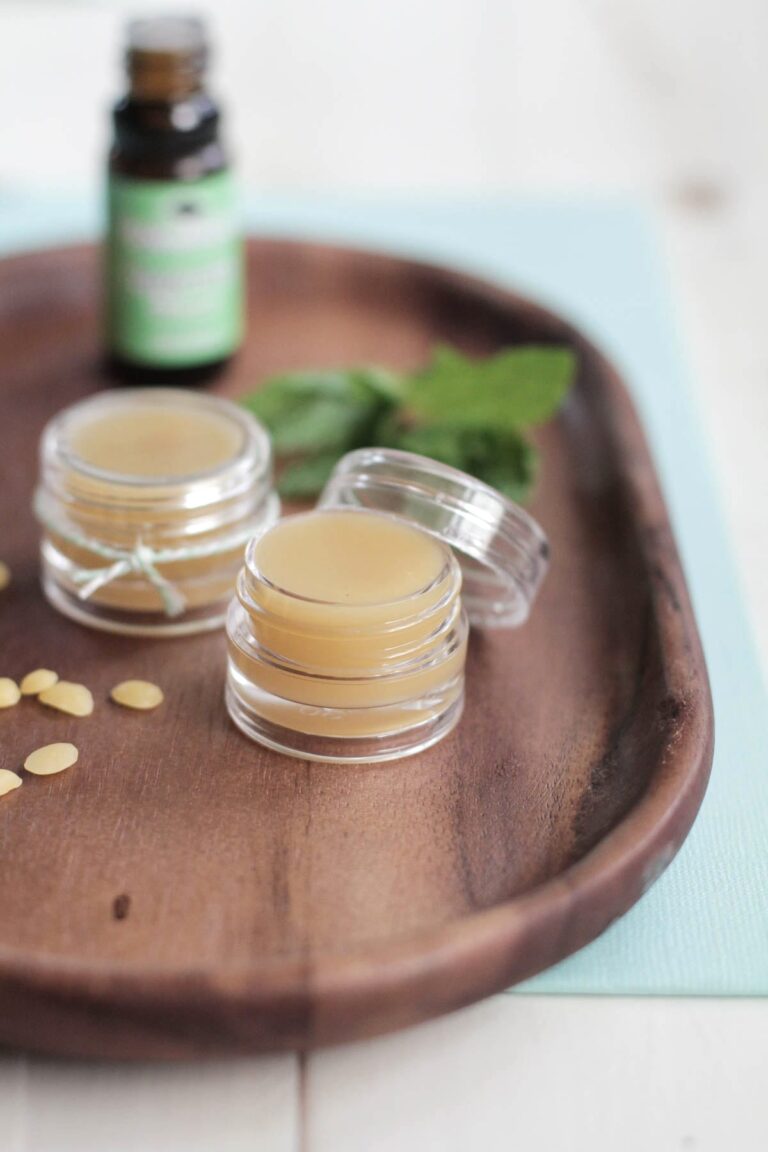
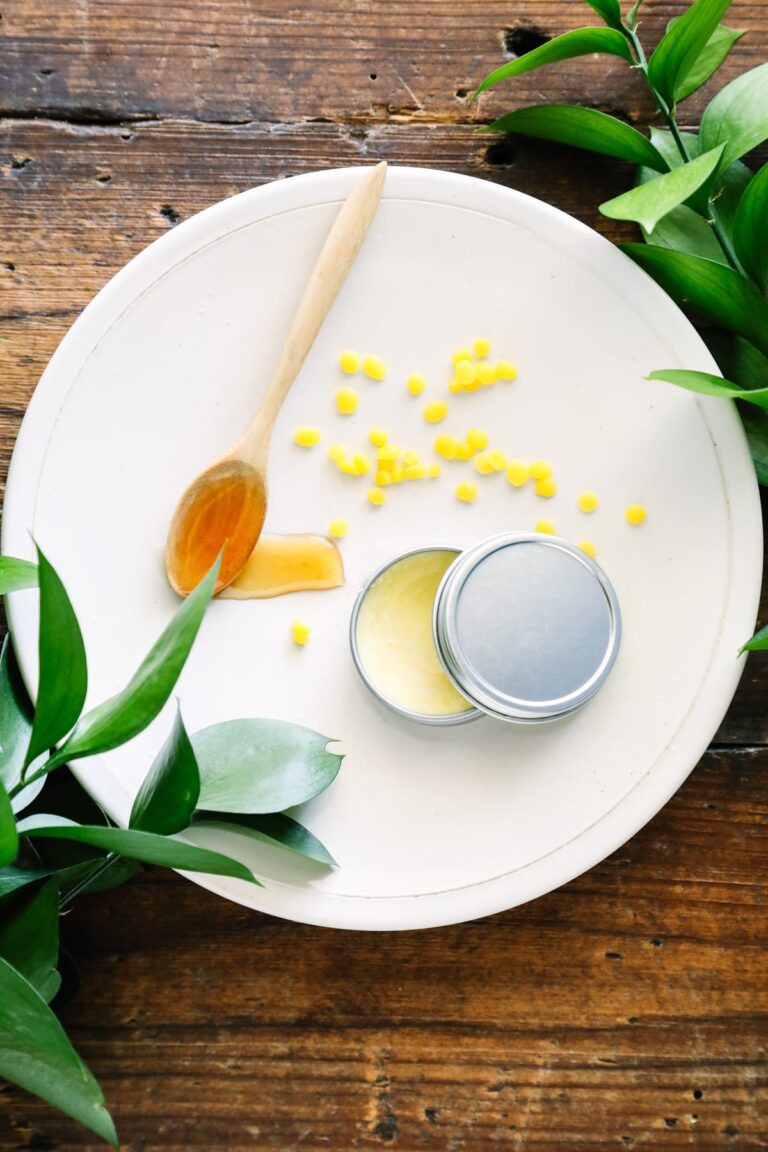
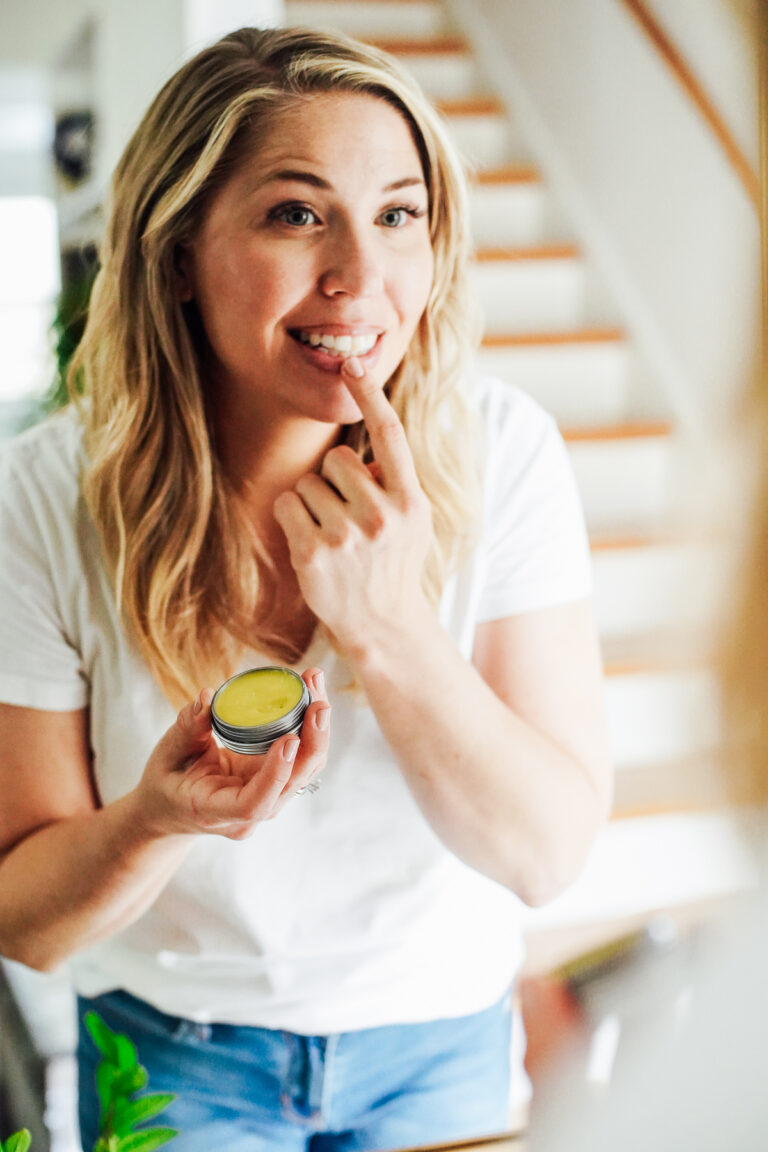
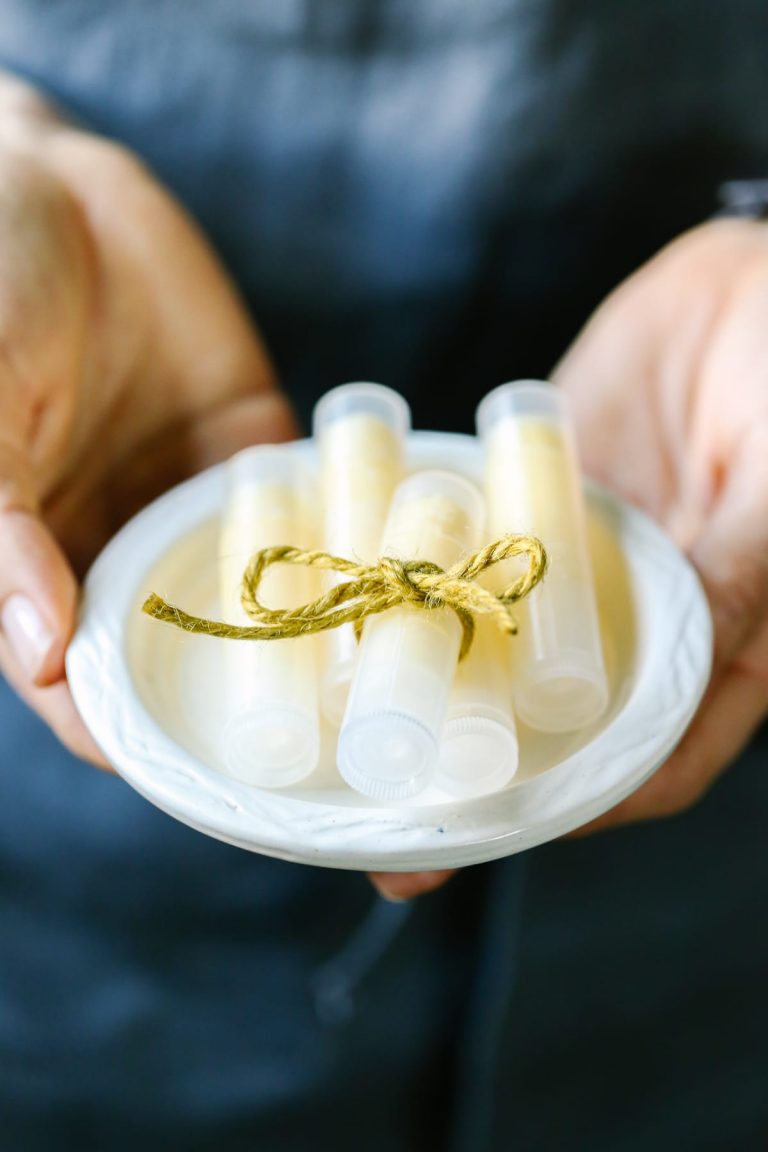
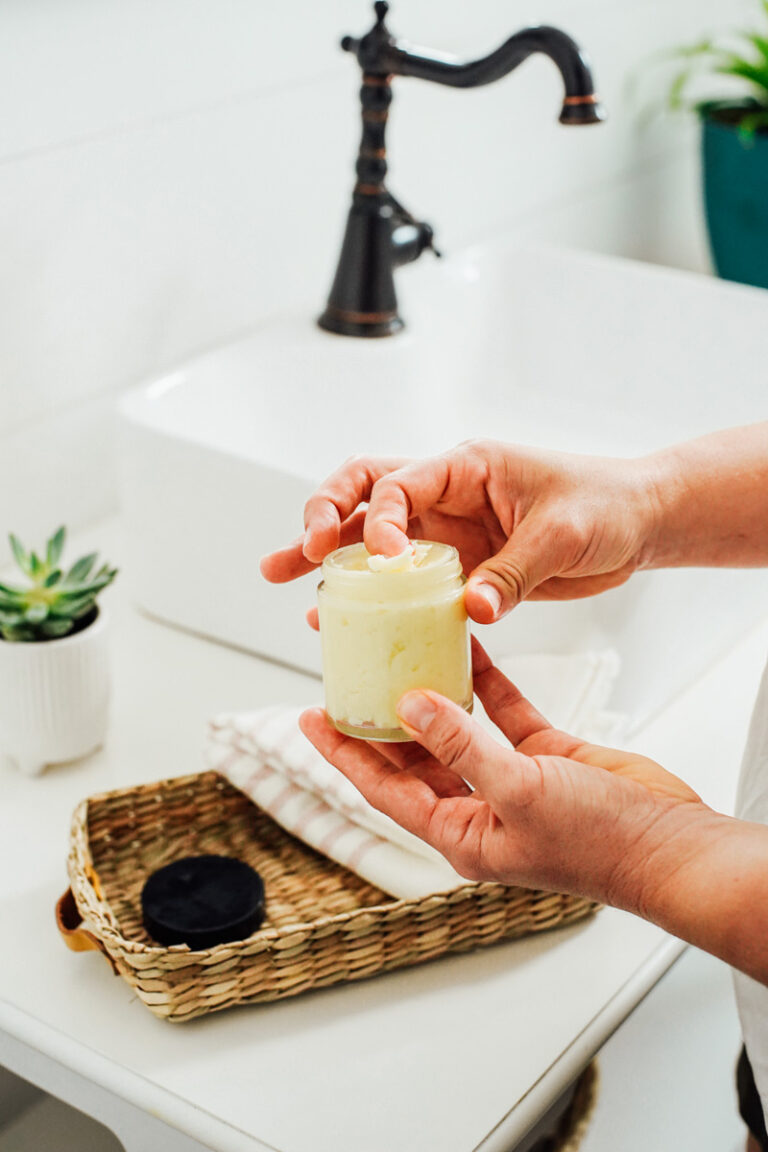
Hi!! I’m in love with your recipe! Haha I’ve been making it for a few weeks now, but just wondering how can I prevent it for completely melting during (really) hot days, thanks!
Hey, I’m so glad you’re enjoying it. You could try adding beeswax to the mixture.
Hi Kristen!
I make a similar recipe as a facial moisturizer that uses beeswax, but does not use any starches. It is “greasy” going on, but I let it sit on my face for about 10 minutes or so, I use that time to get my clothes out for the day and pack my lunch. Then I take a clean dry cotton washcloth and gently dab any remaining oil (if any) before I apply my make-up. I’m 57, so I use essential oils in my moisturizer, such as frankincense and lemon, that are known to help aging skin.
I am excited about trying your body butter recipe! I do not plan to add the arrowroot but use my towel that I showered with to pat off any excess oil.
Just made this recipe. Quadrupled it and substituted 1/4 of the almond oil with argan oil. Didn’t chill long enough so put in freezer and VOILA! Now that it’s done, how can I add the arrowroot after the fact? Just a little greasy, but does soak right in.
I have used Kokum butter with no ill effects
What does the arrowroot do? What is the difference in using it and not using it?
Hey Alaina, It makes it less “greasy” when applied to the skin.
hi, Kristin,
i am a beginner and am trying to create my own body butters. i have a recipe that i have substituted butters and oils to make it what i want. but i am stuck when it comes to ratio of oils to fragrance oils and also how do i turn a recipe from a small amount “say a 40z jar” to a large amount to supply “6 2.3oz smaller jars” . i have tried looking for books but cant find the right one with a good explanation.
I really love your recipe very in-depth and detailed. and some great scents choices.
I have never made any kind of beauty product before and this recipe made me feel like a goddamn CHAMP. Super easy to make with great results. I used mango butter, sweet almond oil as a carrier, arrowroot and lavendar oil and it absorbs nicely into my skin after about 10 minutes. I cooled my first batch in the fridge but it took over an hour and got a little grainy. I cooled my second batch in the freezer and used a hand mixer and it turned out much smoother.
No matter what fragrance I add I still smell shea. Do I use less shea or just deal with it
Will this melt in the summer time at all?
Hey Lani, It shouldn’t.
Hi Kristin,
I tried your body butter using shea butter, cocoa butter, and coconut oil, and I absolutely love it! I had no idea something like this could be created at home and for a fraction of the price charged by brands. The cocoa butter actually makes this smell like chocolate, which I’m more than happy about. I added two teaspoons of arrowroot and experienced no greasiness on my skin. I found that cooling the mixture in the freezer instead of the fridge made it easier & quicker to whip. After this successful attempt, I’m going to definitely try out your lip balm next. Thank you!
I am loving this and plan to make. I would also like to use this recipe and make it an immune boosting foot rub. One that has immune boosting essential oils but also feels nice on our feet as well. Any suggestions? Or do you currently use/make something similar?
I made mine with Shea butter and mango butter, almond oil then geranium and lemon for scent. You can still smell the shea at first but eventually the oils overpower it. Next time I will try arrowroot as it is a little more greasy than shop bought butters but it’s easy and works. Thanks for the recipe, I love it.
I’m so glad you’re enjoying it, Issie!
Fantastic recipe and instructions! After letting mine chill in the fridge for approximately 30 minutes and it still hadn’t hardened, I took it out and mixed it anyways. It looks like creamy white soup (and same consistency) but after leaving it for a few minutes, it hardened right up and feels wonderful to smooth on. I halved the recipe (used coconut oil as my carrier) and included arrowroot. 5 stars — thank you for sharing!
Hi Kristin,
I love your recipes and walking my way through your body care products. Your honey aloe face wash did wonders for my skin (having less luck with castile soap one) I made the body butter last night and it didn’t look as fluffy as yours. Also, the smell of arrowroot is pretty bad. I tried adding more lavender essential oil, but the strange smell is still there. Is there anything that I can do to fix the smell and fluffiness?
Thank you.
Sohini
Hey Sohini, Hmmm, what brand of arrowroot are you using? Usually arrowroot is odorless. And what butter combo did you use? <--The butters used will determine how soft and fluffy the final butter is. The harder the butter, the firmer and more dense the body butter. In the end, the body butter won't be super fluffy in the long-term.
Thank you Kristin! I just used shea. I am going to get some mango butter to make it lighter. I saw that yours looked like whip cream 🙂 and wanted mine to look like that. May be the mango butter will do the trick. I used red mills arrowroot. The smell may be coming from the shea itself. Do you have any tips for anything that I can add for a different smell? I added lavender essential oil. Anything else that you can think of?
Hello Kristin, I’m so happy to stumble into this recipe. I’m going to make one, but can i use avocado oil as the carrier oil? We have some in our kitchen. Tnx
Hey Julai, Thank you. Welcome! Yes, you can :).
Thank you for sharing , I ABSOLUTELY love this recipe! I used Shea and mango butter with apricot oil (I like how quickly it absorbs) and Baby’sBreath fragrance oil to scent. I used just one teaspoon of arrowroot flour and will insrease it next time although after about 30 minutes it no longer felt greasy and left my skin soft and smooth. Already planning for the next batch, going to infuse my carrier oil with chamomile and calendula flowers and use Roman chamomile EO.
Yay, that’s great! Thank you for sharing, Stacy! Love your idea to infuse the carrier oil with the chamomile and calendula.
Could you use beeswax in this in addition with everything else? How much do you think would be good?
Hey Anna, You could, but it will make the product very hard. I would add no more than 1 tablespoon.
I am wondering about the utensils – bowls, blender etc — are they easy to clean and use for other cooking or do you keep them specifically for making body butters – thanx !
Hey Colleen, I recommend using hot water and a detergent-based soap that easily cuts grease (like Seventh Generation or Sal Suds). They are pretty easy to clean using these suggestions.
Wonderful recipe. Question, the containers that you show in pictures with the flip suction ring lids. Where can they be purchased from.
Thankyou for sharing
Char
Hey Char, Thank you. I purchased these from Target (kitchen gadget section).
Hello Kristin,
I’m so glad to have stumbled into your blog. I started switching slowly to natural products (beauty and cleaning) since i got pregnant. My baby boy is 3 months old now. I just made your peppermint lipbalm and wants to make the body butter next but i dont have any of the carrier oils that you mentioned. Can i use olive oil or coconut oil? I will be making your foundation powder next. 🙂
Hey Julai, You could definitely use coconut oil or olive oil. Olive oil will feel a bit heavy, and might be slower to absorb, but it will still work well for moisture. I’m so glad you’re enjoying the lip balm! Congrats, Mama!